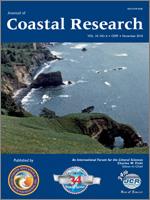Dao, T.; Stive, M.J.F.; Hofland, B., and Mai, T., 2018. Wave damping due to wooden fences along mangrove coasts.
In the Mekong Delta, as in many other mangrove settings, wooden fences are considered beneficial coastal structures to provide sheltering for mangrove replantation efforts by reducing waves and currents and promoting sedimentation. One of the most quantitative previous studies on fence-induced wave reduction offered a first understanding of relevant process parameters. The present application of the advanced numerical time-domain wave model SWASH increases this understanding substantially and explains previously unexplained phenomena that were encountered in this earlier study. The findings reveal that wave damping increases with increasing fence thickness and with increasing density of the woody material in the fences. It further shows that the transmitted wave height (represented by the transmission coefficient) is inversely proportional to the Ursell number, implying that nonlinear waves are damped more effectively.





